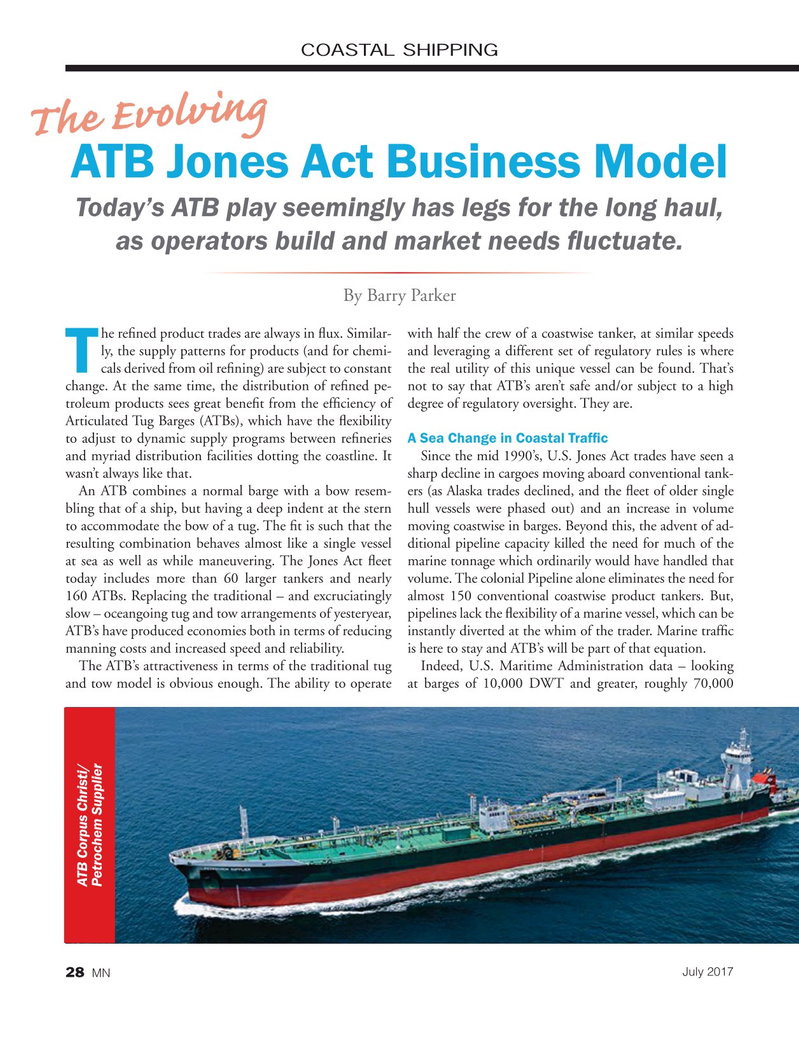
Page 28: of Marine News Magazine (July 2017)
Propulsion Technology
Read this page in Pdf, Flash or Html5 edition of July 2017 Marine News Magazine
COASTAL SHIPPING
The Evolving
ATBJ ATB Jones Act Business Model
Today’s ATB play seemingly has legs for the long haul, as operators build and market needs ? uctuate.
By Barry Parker he re? ned product trades are always in ? ux. Similar- with half the crew of a coastwise tanker, at similar speeds ly, the supply patterns for products (and for chemi- and leveraging a different set of regulatory rules is where
T cals derived from oil re? ning) are subject to constant the real utility of this unique vessel can be found. That’s change. At the same time, the distribution of re? ned pe- not to say that ATB’s aren’t safe and/or subject to a high troleum products sees great bene? t from the ef? ciency of degree of regulatory oversight. They are.
Articulated Tug Barges (ATBs), which have the ? exibility to adjust to dynamic supply programs between re? neries A Sea Change in Coastal Traf? c and myriad distribution facilities dotting the coastline. It Since the mid 1990’s, U.S. Jones Act trades have seen a wasn’t always like that. sharp decline in cargoes moving aboard conventional tank-
An ATB combines a normal barge with a bow resem- ers (as Alaska trades declined, and the ? eet of older single bling that of a ship, but having a deep indent at the stern hull vessels were phased out) and an increase in volume to accommodate the bow of a tug. The ? t is such that the moving coastwise in barges. Beyond this, the advent of ad- resulting combination behaves almost like a single vessel ditional pipeline capacity killed the need for much of the at sea as well as while maneuvering. The Jones Act ? eet marine tonnage which ordinarily would have handled that today includes more than 60 larger tankers and nearly volume. The colonial Pipeline alone eliminates the need for 160 ATBs. Replacing the traditional – and excruciatingly almost 150 conventional coastwise product tankers. But, slow – oceangoing tug and tow arrangements of yesteryear, pipelines lack the ? exibility of a marine vessel, which can be
ATB’s have produced economies both in terms of reducing instantly diverted at the whim of the trader. Marine traf? c manning costs and increased speed and reliability. is here to stay and ATB’s will be part of that equation.
The ATB’s attractiveness in terms of the traditional tug Indeed, U.S. Maritime Administration data – looking and tow model is obvious enough. The ability to operate at barges of 10,000 DWT and greater, roughly 70,000
ATB Corpus Christi/
Petrochem Supplier
July 2017
MN 28

 27
27

 29
29
